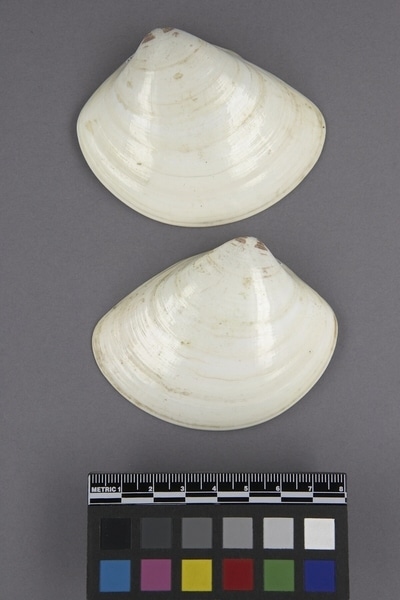Game Pieces Item Number: 1042/18 a-b from the MOA: University of British Columbia


Description
Two halves (parts a-b) of a cream-coloured clam shell, used for kaiawase (貝合わせ), a shell matching game. The interiors are predominantly painted gold, with painted images of uchide no kozuchi (打ち出の小槌), a legendary magic hammer in the centre, with a different coloured sack at each side. A horizontal green band across the middle represents a river. The shells have polished, natural exteriors.
History Of Use
Kaiawase (貝合わせ), or the game of matching shells, was originally played by court women during the Heian period (794–1185). The game was later played by different classes, and became popular during the Edo period (1603–1868). A complete set of kaiawase contains 360 pairs of shells around the same size. Each pair was decorated with images from literature or nature. The shells are divided into 2 groups; one group, ji-gai (地貝) is scattered on the floor; the other group, dashi-gai (出し貝) are produced by the participants, who compete in finding the correct counterpart on the floor. The winner is decided by obtaining the greatest number of matching pairs.
Narrative
This pair is part of an incomplete set of game pieces, including 1042/18 a-b; 1042/19 a-b; 1042/20 a-b; 1042/21 a-b, 1042/22 a-b.
Item History
- Made in Japan
- Owned by Aileen P. Walker before June 18, 1985
- Received from Aileen P. Walker (Donor) on June 18, 1985
What
- Name
- Game Pieces
- Identification Number
- 1042/18 a-b
- Type of Item
- game piece
- Material
- clam shell and paint
- Part A
- height 2.4 cm, width 8.0 cm, depth 6.5 cm
- Part B
- height 2.4 cm, width 8.0 cm, depth 6.5 cm
Who
- Culture
- Japanese
- Previous Owner
- Aileen P. Walker
- Received from
- Aileen P. Walker (Donor)
Where
- Holding Institution
- MOA: University of British Columbia
- Made in
- Japan
When
- Ownership Date
- before June 18, 1985
- Acquisition Date
- on June 18, 1985
Other
- Condition
- fair
- Current Location
- Case 79
- Accession Number
- 1042/0018 a-b